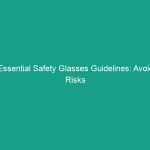Introduction
In the fast-paced world of construction, the principles of Health, Safety, and Environment (HSE) have become increasingly critical to ensuring worker Safety and environmental protection. The construction industry is one of the most hazardous sectors, and the need for effective Safety Measures cannot be overstated. This is particularly true in the context of modular and prefabricated construction, where unique challenges arise due to the off-site assembly of components. In order to promote Safety in Modular and Prefabricated Construction, it’s important to understand the regulatory frameworks, best practices, and emerging trends that define this area.
Understanding the Regulatory Framework
Regulatory frameworks are crucial for enforcing Safety Standards in the construction industry. They provide the legal backbone that ensures compliance and accountability among construction firms. In the context of modular and prefabricated construction, these Regulations can vary significantly by region and type of project.
Key Regulations and Standards
Several key regulations and standards govern safety in construction. These include:
- Occupational Safety and Health Administration (OSHA): osha sets forth guidelines that ensure safe working conditions for employees. Compliance with these standards is mandatory for all construction projects.
- National Fire Protection Association (NFPA): NFPA codes are critical for fire safety, especially in modular units that may house multiple occupants.
- International Organization for Standardization (ISO): ISO standards, such as ISO 45001, focus on Occupational Health and safety management systems.
Compliance Challenges
While these regulations are in place, compliance can be challenging. Modular construction projects often involve multiple jurisdictions, each with its own regulations. The complexity increases when projects are conducted across state or national borders, necessitating a thorough understanding of varying safety laws. Additionally, the prefabrication process often involves manufacturing components in a controlled environment, leading to a misconception that the site itself is safer, which can result in complacency regarding safety practices.
Best Practices for Ensuring Safety
Implementing Best Practices is essential for promoting safety in modular and prefabricated construction. These practices can significantly reduce the risk of accidents and enhance overall project safety.
Risk Assessment
Conducting a comprehensive risk assessment before the commencement of any construction project is vital. This process involves identifying potential Hazards, evaluating the risks associated with those Hazards, and implementing appropriate Control Measures. Regular updates to the risk assessment should be made as the project evolves, especially when new elements are introduced during the modular construction process.
Training and Education
Education plays a pivotal role in promoting safety. All workers should undergo rigorous safety Training tailored to the specific hazards associated with modular construction. This training should encompass:
- Safe handling and installation of prefabricated components.
- Emergency response Procedures.
- Proper use of Personal Protective Equipment (PPE).
Ongoing training and refresher courses are also important to keep workers informed about new safety protocols and technologies.
Use of Technology
The integration of technology can greatly enhance Safety Measures in modular and prefabricated construction. Technologies such as drones for site inspections, Building Information Modeling (BIM) for planning and safety simulations, and wearable safety devices that monitor workers’ health can contribute to a safer work environment. The use of these technologies helps in identifying potential hazards before they can cause harm.
Case Studies in Modular Construction Safety
Examining real-world case studies can provide valuable insights into effective safety practices in modular and prefabricated construction. These examples illustrate the importance of safety measures and the consequences of neglecting them.
Case Study 1: Modular Housing Project in New York
A modular housing project in New York faced significant safety challenges due to the tight construction schedule. The project team implemented a stringent safety protocol that included daily safety briefings, site inspections, and a zero-tolerance policy towards Unsafe Behavior. As a result, the project completed on time without any major incidents, demonstrating that proactive safety measures can lead to successful outcomes.
Case Study 2: Prefabricated School in California
A prefabricated school project in California adopted advanced technology to enhance safety. By utilizing BIM, the project team was able to visualize potential hazards and plan accordingly. Additionally, the use of drones for regular inspections allowed for timely identification of issues before they escalated. This proactive approach resulted in a significantly reduced incident rate throughout the project.
Challenges in Modular and Prefabricated Construction
Despite the advantages of modular and prefabricated construction, various challenges can impede safety efforts. Understanding these challenges is the first step in addressing them.
Workforce Variability
One of the primary challenges in modular construction is the variability in the workforce. Modular construction projects often involve multiple subcontractors, each with their own safety cultures and practices. This can lead to inconsistencies in safety protocols and increase the risk of accidents. Establishing a cohesive safety culture across all teams is essential for ensuring safety in modular construction.
Logistical Issues
Logistical challenges can also impact safety. The transportation of prefabricated modules can pose risks during loading, transit, and unloading. Ensuring that all transportation personnel are trained in safety protocols and that all materials are secured properly is crucial. Additionally, the timing of deliveries must be coordinated to avoid congestion at the construction site, which can lead to accidents.
Regulatory Compliance
As previously mentioned, navigating the complex landscape of regulations can be daunting. Ensuring compliance with local, state, and federal regulations requires thorough planning and ongoing communication with regulatory bodies. This complexity can lead to delays, increased costs, and potential safety risks if not managed effectively.
Future Trends in Modular Construction Safety
The future of modular and prefabricated construction is bright, with numerous trends emerging that promise to enhance safety further. These trends should be closely monitored and adopted as necessary.
Sustainability and Safety
As Sustainability becomes increasingly important in construction, there is a growing focus on environmentally friendly practices that also enhance safety. For instance, using sustainable materials can reduce the risk of exposure to harmful substances. Additionally, implementing energy-efficient systems can improve air quality, contributing to the overall health and safety of workers.
Automation and Robotics
Automation and robotics are set to revolutionize the construction industry, including modular construction. By automating repetitive and hazardous tasks, companies can significantly reduce the risk of accidents. For example, robotic arms can be used for assembly tasks that require precision, minimizing the risk of worker injury.
Data-Driven Decision Making
Data analytics will play an increasingly crucial role in enhancing safety in modular and prefabricated construction. By collecting and analyzing data from various sources, construction firms can identify patterns and trends related to safety incidents. This data-driven approach allows for more informed decision-making and the implementation of targeted safety measures.
Conclusion
In conclusion, ensuring Safety in Modular and Prefabricated Construction is a multifaceted challenge that requires a comprehensive understanding of regulations, best practices, and emerging trends. By adopting a proactive approach to safety, including thorough risk assessments, ongoing training, and the integration of technology, construction firms can significantly reduce the risk of accidents and create a safer work environment. As the industry continues to evolve, staying informed and adaptable will be key to maintaining high safety standards. We encourage all stakeholders in modular and prefabricated construction to prioritize HSE practices and make a commitment to safety on every project.


